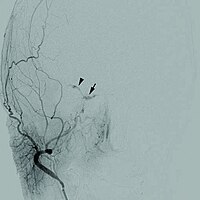
Photo from wikipedia
Type of funding sources: None. Acute coronary syndrome (ACS) remains a frequent cause of hospital admission, with its prognosis depending on many factors, one being the location of the culprit… Click to show full abstract
Type of funding sources: None. Acute coronary syndrome (ACS) remains a frequent cause of hospital admission, with its prognosis depending on many factors, one being the location of the culprit lesion. It is established that anterior myocardial infarction, caused mostly by left anterior descending artery occlusion is associated with a worse prognosis and higher morbimortality. Therefore, identifying patients at a higher risk of significant LAD lesions could potentially impact outcomes. We aim to identify if having personal history of cerebrovascular events could be related to more severe LAD stenosis. We retrospectively analysed a population of 988 patients (L) admitted with ACS and divided them into two groups: those who had significant stenosis of the left anterior descending artery (LAD) documented in coronary angiography, defined as a stenosis above 50% (L1), and those who had no significant stenosis of the LAD (L2), which included those with no stenosis or stenosis under 50%. We then compared the prevalence of previous cerebrovascular events, defined as stroke or TIA, between both groups. Age, sex, personal history of smoking, hypertension, dyslipidaemia and diabetes mellitus were also documented. L1 was comprised of 553 patients (56,0% of the population). When comparing between groups, results show that L1 had a significantly higher prevalence of previously documented stroke or TIA (1,4% vs 0,2%, p=0,026; odds ratio: 7,628, 95% CI [0,922; 63,120]) than L2. Regarding age, sex and history of hypertension, dyslipidaemia and diabetes, there were no relevant differences and no impact on the severity of the LAD stenosis. Patients with ACS and previous history of cerebrovascular events have a sevenfold-increased risk of having significant LAD stenosis on coronary angiography. This could potentially impact pre-procedure risk stratification and timing of percutaneous intervention.
Journal Title: European Journal of Preventive Cardiology
Year Published: 2023
Link to full text (if available)
Share on Social Media: Sign Up to like & get
recommendations!